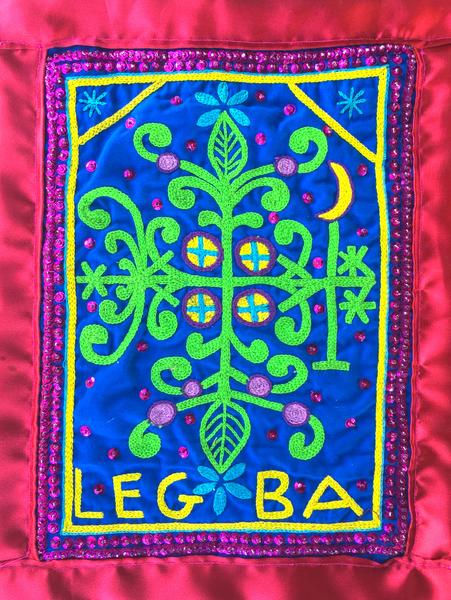The Women Artists of Matènwa: An Explanation of a Few Common Haitian Vodou Symbols
Atis Fanm Matènwa, or Women Artist Matènwa, is a longstanding Women’s Haitian Arts collective in the Matènwa community in La Gonave. Women from the Matènwa community create and customize beadwork, embroidery, painted silk scarves and other Haitian art by hand. Some of their exquisite customized art integrated symbols from the Haitian Vodou religion. Let’s take a look at what some of these symbols mean.
You can request their handiwork by clicking here.
Many of the graphic designs have symbolic meanings in Vodou. The most common symbol that you will see is the Erzulie Freda Veve. This symbol according to Exemplore, "is the goddess people view as the most beautiful and the one who can help with love and romance. Erzulie Freda embodies love and is the spirit of beauty, jewelry, dancing, luxury, and flowers. She represents the epitome of femininity and compassion. She is frequently invoked to help find a lover, or renew a love relationship. Erzulie Freda is considered a Rada Lwa and so her domain is water and she lives on the riverbanks. Her colors are white and pink. She wears three wedding bands for her three husbands: Damballa, the serpent Lwa, Agwe, the patron Lwa to fishermen, and Ogun Feray, the patron Lwa of iron and technology. Her symbols are a heart, a mirror, and a fan".
Another symbol replicated is this symbol called Papa Legba's Veve. Papa Legba according to Exemplore is the "Guardian of the Crossroads. Papa Legba is the master linguist, the trickster, warrior, and the personal messenger of destiny. He has the power to remove obstacles and he provides opportunities.
All ceremonies begin and end with Papa Legba, as it is he who opens the gates to the world of the Invisibles, much like St. Peter traditionally throws wide the gates to heaven. There can be no communication with any of the other Loas without consulting him first. His gift for linguistics enables him to translate the requests of humans into the languages of the Spirits, the Orishas, and the Loas. Voodoo practitioners place representations of Papa Legba behind the front door of their home in order to clear the path, accomplish goals, and to bring his protection".
Another Haitian Vodou symbol is called Marassa Veve. This article discusses the “Haitian Vodou tradition known as La Marassa or Marassa Jumeaux, the “Divine Twins”. The Marassa are also known as “twins of three”– truly triplets–and appear as such, as double or triple figures, to represent double or triple blessings, or could represent a binary (gluttony/starvation) or double or triple virtues (such as faith, hope, and charity).”
According to Voodoo, Marassa Veve is a symbol of opposites, including the live, and the dead or day vs night. It is "paid to live and dead twins (who) has its roots in the veneration of godly twins: Mawa and Lisa. They symbolize active male and passive female energy, they personify the sun and the moon. Together they create a hermaphrodite (bisexual) god that symbolizes inseparable divine unity. Twins, especially if it is a boy (Dossou) and a girl (Dossa) are considered as their earthly delegates. The birth of twins is in every case associated with a number of problems as they are seen as exceptionally powerful creatures. They are foreseen as difficult, impulsive, sensitive and malicious (mischievous, vicious) beings."
Enjoy this music video (Voodoo You Do, 2016) by the charming and talented singer AYIITI. Comment below and spot how many Haitian Vodou symbols you can recognize.





























